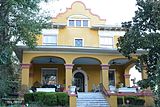
The Johnston–Felton–Hay House, often abbreviated Hay House, is a historic residence at 934 Georgia Avenue in Macon, Georgia. Built between 1855 and 1859 by William Butler Johnston and his wife Anne Tracy Johnston in the Italian Renaissance Revival style, the house has been called the "Palace of the South." The mansion sits atop Coleman Hill on Georgia Avenue in downtown Macon, near the Walter F. George School of Law, part of Mercer University. It was designated a National Historic Landmark in 1973 for its architectural uniqueness.

The Georgia Trust for Historic Preservation is the United States' largest statewide, nonprofit preservation organization with more than 8,000 members. Founded in 1973 by Mary Gregory Jewett and others, the Trust is committed to preserving and enhancing Georgia's communities and their diverse historic resources for the education and enjoyment of all.
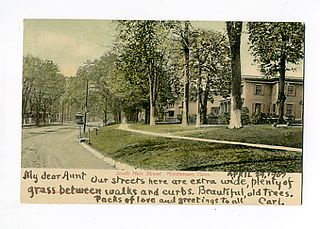
Located in Middletown, Connecticut, the Middletown South Green Historic District was created to preserved the historic character of the city's South Green and the historic buildings that surround it. It is a 90-acre (36 ha) historic district that includes a concentration of predominantly residential high-quality architecture from the late 19th century. It was listed on the National Register of Historic Places in 1975.
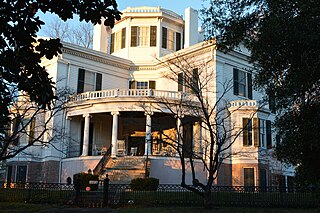
The Carmichael House, known also as Raines-Carmichael House, Raines-Miller-Carmichael House or Cadwalader Raines House, is a Greek Revival mansion at 1183 Georgia Avenue in Macon, Georgia, United States. Built in 1848, the house is a nationally significant example of Greek Revival architecture, built and designed by local master builder Elam Alexander. It was declared a National Historic Landmark in 1973.

The Donehoo-Brannen House is a historic house located at 332 Savannah Avenue in Statesboro, Georgia.
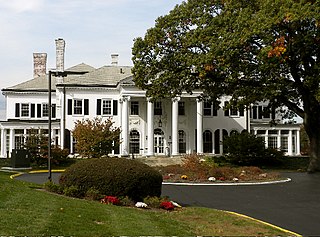
The Prospect Hill Historic District is an irregularly-shaped 185-acre (75 ha) historic district in New Haven, Connecticut. The district encompasses most of the residential portion of the Prospect Hill neighborhood.

The Whitney Avenue Historic District is a historic district in the East Rock neighborhood of New Haven, Connecticut. It is a 203-acre (82 ha) district which included 1,084 contributing buildings when it was listed on the National Register of Historic Places in 1989.

The Joseph and Mary Jane League House, also known as the League House, is located in Macon, Georgia. It is significant for its architecture and for its association with two of the first female architects in Georgia: Ellamae Ellis League and her daughter Jean League Newton. It was listed on the National Register of Historic Places in January 2009

The Carlowville Historic District is a historic district in the community of Carlowville, Alabama. The historic district covers 780 acres (320 ha) and is centered on Alabama State Route 89 and Dallas County roads 4, 47 and 417. It was placed on the National Register of Historic Places on January 18, 1978.

The Riverview Terrace Historic District is a 15.2-acre (6.2 ha) historic district in Davenport, Iowa, United States, that was listed on the National Register of Historic Places in 1984. It was listed on the Davenport Register of Historic Properties in 1993. The neighborhood was originally named Burrow's Bluff and Lookout Park and contains a three-acre park on a large hill.
This is a list of properties and districts in Bibb County, Georgia that are listed on the National Register of Historic Places (NRHP).

The Downtown Athens Historic District is a historic area in the Downtown Athens neighborhood of Athens, Georgia. It was listed on the National Register of Historic Places in 1978. Its boundaries were revised twice, in 1984 and 2006, and additional documentation was filed in 2006.

The Prospect Avenue Historic District encompasses a predominantly residential area in western Hartford and eastern West Hartford, Connecticut. The 300-acre (120 ha) historic district extends along Prospect Avenue from Albany Avenue to Fern Street, including most of the area between those streets and the Park River to the east, and Sycamore Street and Sycamore Lane to the west. The district includes 240 contributing buildings and 48 non-contributing buildings, most of them residences built between 1880 and 1930. The district was listed on the National Register of Historic Places in 1985.
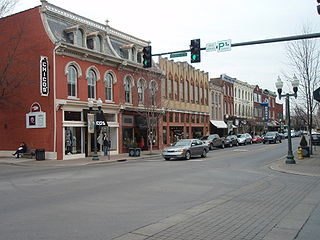
Franklin Historic District is a historic district in Franklin, Tennessee that was listed on the National Register of Historic Places in 1972. It was created to preserve historic commercial and residential architecture in a 16-block area of the original, downtown Franklin around the north, west, and south of the town square.

The Cowles–Woodruff House, listed on the National Register of Historic Places as the Cowles House and also known as the Woodruff House or the Cowles–Bond House, is owned by Mercer University in Macon, Georgia and is located at 988 Bond Street. It is an antebellum home the overlooks downtown Macon. It was used by General James H. Wilson as his residence and headquarters during the occupation of Macon by the US Army in 1864. From 1960 to 1978 it was the campus of Stratford Academy, a segregation academy formed by white parents seeking to avoid racially integrated public schools.

Louisburg Historic District is a national historic district located at Louisburg, Franklin County, North Carolina. The district encompasses 206 contributing buildings, 1 contributing site, 6 contributing structures, and 1 contributing object in residential sections of Louisburg included in the original 1779 town plan. It also includes a section of Louisburg College located on the old Town Commons. Dwellings date between about 1800 and the 1920s and include notable examples of popular architectural styles including Federal / Georgian, Italianate / Greek Revival, Queen Anne, Colonial Revival, Late Victorian, and Bungalow / American Craftsman. Located in the district and separately listed are the Fuller House, Williamson House, and Main Building, Louisburg College. Other notable buildings include the Shine-King House, Milner-Perry-Boddie-Dennis House, Dr. J.B. Clifton House, The Edgerton-Pruitt House, The Furgurson-Hicks House, Nicholson-Bickett-Taylor House, The Hughes-Watson-Wheless House, Bailey-Yarborough House, The Barrow House, The Neal-Webb House, The Milner-Williams-Person Place, Former Rectory-St. Paul's Episcopal Church, Hicks-Perry-Bland-Holmes House, Malcomb McKinne House First Baptist Church (1927), Louisburg United Methodist Church (1900), and Louisburg Baptist Church (1901-1904).

Ellamae Ellis League, was an American architect, the fourth woman registered architect in Georgia and "one of Georgia and the South's most prominent female architects." She practiced for over 50 years, 41 of them from her own firm. From a family of architects, she was the first woman elected a Fellow of the American Institute of Architects (FAIA) in Georgia and only the eighth woman nationwide. Several buildings she designed are listed on the National Register of Historic Places (NRHP). In 2016 she was posthumously named a Georgia Woman of Achievement.
Dennis & Dennis was an architectural partnership in the U.S. state of Georgia which was Georgia's oldest architectural firm. It designed numerous commercial, institutional and residential buildings in Macon and other Georgia communities.

The Ellamae Ellis League House is a historic house in Macon, Georgia. The house was designed and owned by local architect Ellamae Ellis League and has been listed on the National Register of Historic Places since 2005.

The Porterdale Historic District in Porterdale, Georgia is a 525 acres (212 ha) historic district which was listed on the National Register of Historic Places in 2001. Its area is roughly the city limits of Porterdale north of Elm St., and it includes Colonial Revival, Late Gothic Revival, and other architecture. In 2001 it included 496 contributing buildings and eight contributing structures. It also included 37 non-contributing buildings and a non-contributing object.



